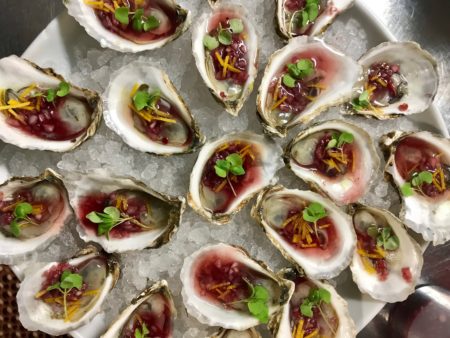As a pescatarian who also doesn’t eat dairy, I tend to eat a lot of seafood, but if you don’t have the same restrictions or preferences, eating seafood might not be top of mind. However, new dietary guidelines confirm it should be. Earlier this week I went to an event at Crave Fishbar hosted by the Seafood Nutrition Partnership (SNP) and learned that two servings of seafood per week is the recommended guideline for Americans by many leading health organizations. Yet, on average, Americans are consuming ten times more sugar than seafood each year! Only one in 10 consumers eat seafood twice a week. Why so few seafood lovers? Most people feel stumped about how to eat more seafood – what to look for, how to prepare it or they think that it smells unpleasant. As a health coach, if there’s a reason excuse for why seafood isn’t on most dinner tables, I’ve heard it. Whatever your questions or hang-ups may be, I’ve got an answer in this comprehensive guide for how to eat more seafood.
Why Seafood?
Obviously, I’m partial to seafood, but why should you be when there are so many other sources of animal protein to choose from? Lots of reasons, actually.
Seafood improves overall health: Two to three servings per week can prevent health-related deaths caused by heart disease, Alzheimer’s cancer and other life-threatening illnesses.
Seafood is protein-rich: Not only is seafood high in protein, it’s a high-quality protein.
Seafood is good for your brain: Seafood contains two types of long-chain Omega-3 fatty acids – EPA and DHA – which are responsible for brain function and development – and has implications for preventing and treating depression and dementia. For healthy people, the daily recommended amount of EPA and DHA Omega-3s is 250 to 500 milligrams. For those with heart disease, it’s twice that amount. Seafood richest in Omega 3s include anchovies, herring, mackerel, oysters, black cod, sardines, salmon, swordfish and trout. Pollock, crab, mussels, sea bass and tuna are also good sources of this brain food.
Beyond Omega-3s
Perhaps it’s most notable for being high in Omega-3 fatty acids, but nutrition-wise seafood delivers an even bigger punch in the form of nutrients like selenium, iron, vitamins B-12 and B-6 and lots of protein. Clams are high in B-12, which regulates mood and so are sardines. Sardines are also a good source of calcium. For lean protein, cod and shrimp are the best choices while shrimp also packs high levels of selenium to support a healthy metabolism. Lobster is a good source of iodine which supports thyroid function and oysters are high in iron. Salmon and swordfish are both rich in Vitamin D.
Farmed, Fresh, Frozen, Wild, Canned – What’s the Deal?
There are so many tricky terms when it comes to seafood, it’s not surprising people are confused about how to eat more seafood. What does it all even mean? These are a few of the buzzwords you’ve probably encountered in the supermarket:
Fresh refers to fish that hasn’t been previously frozen. It’s often local or from nearby waters and should be cooked soon after purchase. Always ask about how the fish was caught, how long it’s been on display and where it’s from.
Frozen commonly refers to premium fish that’s been flash-frozen within hours of harvesting to preserve freshness and texture. Freezing fish at peak freshness reduces carbon emissions that typically result from air transportation and food waste.
Farming is a method of raising fish using less land, energy and water. If done right, it reduces the use of carbon dioxide, however poor farming practices can be dangerous for the fish, consumers and the environment. Although it’s safe to eat, I avoid farmed fish, but if you choose to buy it, look for fish that are Aquaculture Stewardship Council (ASC) or Best Aquaculture Practices (BAP) certified.
Wild fish are harvested using non-destructive, selective fishing methods. Unregulated or illegal fishing has led to overfishing and population decline. When selecting wild seafood, avoid red-listed fish on the Seafood Watch and choose local species and smaller fish.
Canned seafood is a good option for convenience and if you’re on a budget. It’s shelf-stable and stores well in the pantry making it perfect to have on hand for quick meals and snacks.
There are many opinions about farmed vs. wild-caught fish but regardless of which you choose to eat, always ensure your fish is sustainable, caught or farmed with minimal environmental impact. Not only is it healthier – higher in Omega 3s and lower in mercury- you’ll get a better-quality fish at more affordable prices. You can also be assured that you’re supporting local economies and protecting the oceans and thousands of endangered species.
How to Buy Seafood
Approaching a fish counter can be intimidating if you don’t know what you’re looking for. Below are a few of the decisions you’ll need to make and guidance on each.
Flavor: First, determine the flavor you want. Some fish have a fuller, more robust flavor like sardines, mackerel, salmon, trout or tuna while others impart a more delicate or mild flavor like flounder, cod, halibut or pollock. If you’re new to eating seafood, start with a more mild-flavored fish. The fattier fish, those with more than 5 percent fat, tend to have a richer, more pungent flavor.
Whole vs. Fillet: You’ll often see whole fish prominently displayed at any fish counter, but don’t let that intimidate you. Filleted fish are always available. If you don’t see it, you can always ask for a whole fish to be filleted for you. Go for fillets as a quick and convenient option and if you’re looking for simple preparation like sauteeing. With a fillet, you won’t have to deal with bones. A whole fish is a good choice for the more experienced home cook or if you’re planning to roast or grill the fish. A whole fish can often be a better value and is ideal if you want to use the entire fish (bones and head) in something like a bone broth or stock later.
Frozen vs. Fresh: When buying frozen fish, look for individually-wrapped, vacuum-packed pieces. These store well in a home freezer and can be thawed as needed. Fresh fish should have a bouncy flesh and be firm with shiny skin and clear bright eyes. Whether fresh or frozen, always look for a sustainability certification on the label or store signage. As for the smell, it should smell like the ocean. Pass on anything with a fishy or unpleasant odor.
Bought It, Now What?
When you get your fish home, store it on ice or in the refrigerator and plan to use fresh or defrosted seafood right away – within one to two days. If you won’t be using it immediately, you can always freeze fresh fish in a home freezer, just make sure it hasn’t been frozen previously. Canning, smoking and salting are other ways to preserve fish if you’re more seasoned in the kitchen.
Once you’re ready to prepare your selection, defrost frozen fish by thawing it overnight in the refrigerator or if you have less time, soak vacuum-packed fish in cold water for 15-20 minutes. Clean, scale and fillet the fish if it needs to be and then choose your cooking method.
En Papillote is a simple way to prepare fish by seasoning it – I like to keep it simple with garlic, olive oil, lemon, fresh herbs and cherry tomatoes – then wrapping it loosely in parchment paper and roasting it in the oven.
Grilling is ideal for whole fish or fillets with the skin on. Brush the fish with oil and season with herbs to grill over high heat.
To pan sear, make some shallow scores in the skin and cook it skin-side down until crispy then flip and cook it on the other side.
Poaching is a gentle method of cooking, or steaming, fish submerged in a simmering stock.
Roast thawed or frozen fish in the oven at 400 F.
No grill? Bake or Broil fish in the oven to impart a similar flavor as grilling.
Like I mentioned earlier, if you’re preparing a whole fish, you can use the head and bones to make a nutritious stock. Add everything to boiling water with onions, carrots, celery, garlic and your favorite herbs.
Regardless of which fish you choose or how you prepare it, enhance the nutrition-value and flavor of your fish by serving it with fresh vegetables, whole grains, fresh herbs and spices and homemade marinades and tapenades.
Is It Cooked?
Part of the mystery with cooking fish is knowing when it’s done. There’s a fine line between over- and under-cooking fish. Shrimp will turn bright pink and firm up while scallops become white or opaque. Oysters, clams and mussel shells will open up. Fish isn’t always so obvious. Measure the fish at its thickest point and use the 10-minute rule – cook at 350 F for 10 minutes per inch, turning halfway through. Fish should reach an internal temperature of 145 degrees. If all else fails, try the fork test. Insert a fork at an angle at the thickest part of the fish and gently twist the fork. The fish should flake and have no signs of translucence.
But What About the Smell?
This is a common concern I hear from a lot of my clients, but I think it’s silly for this to keep anyone from preparing seafood at home. If you’re concerned about cooking fish at home because of the smell, consider that cooking steak and other heavy proteins often give off a stronger smell and more smoke. Some suggestions for managing the aroma includ lighting a citrus candle, baking cinnamon and sugar in the oven after cooking fish and cleaning up soon after.
Now that you’re armed with everything you need to know about how to eat more seafood, you can get started right away! User fish like a blank canvas to create wholesome flavorful dishes you love!




Leave a Reply